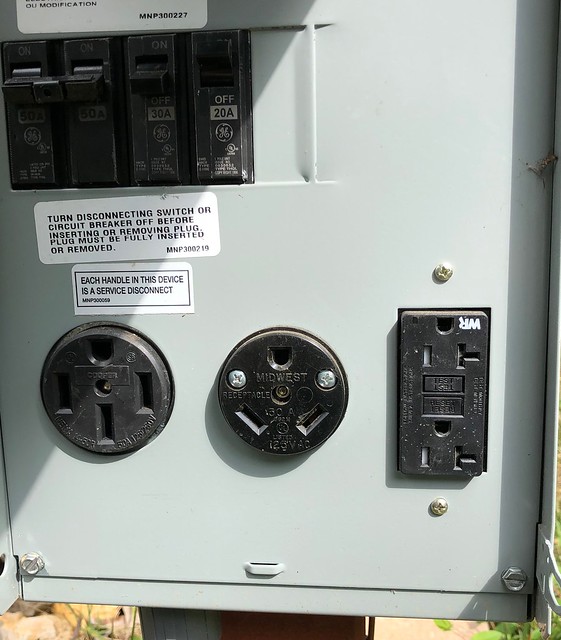My wife and I should be taking delivery of a Model 3 LR in the next month or so.
As background, we've been driving a 2018 Honda Clarity PHEV for over 3 years and now have about 62,000 trouble free miles on it. With an average of 47 miles EV range, almost all our local driving is all or majority EV. Road trips in hybrid mode yield about 42 mpg, which is great for a car this size. We can usually top off the battery overnight on a standard 120v receptacle, even at a rate of about 4 mrph.
But we have a 240v 30A receptacle we can plug our stock EVSE into via a home made adapter, which draws 16A and ups the mrph to about 10. It's a twist-lock generator receptacle which normally powers a hangar door.

That way in a power failure we can still get the hangar door open by plugging the door into our 240v generator. Here it is charging the Clarity:

I plan on using this feed for the Tesla. I'm considering "piggy-backing" a 240v 30A receptacle onto the existing generator receptacle, just being careful never to operate the hangar door while charging. Or possibly putting a selector switch in, though that introduces a lot of new failure points. These are the two receptacle styles I'm considering:

A couple questions:
1) Anything to make either the 10-30 or the 14-30 preferable? Clearly on the 14-30 one blade would remain unused.
2) There are only 3 wires running to the location, 2 hots and a ground, no neutral. Clearly the Tesla EVSE doesn't need a neutral, since there are adapters for several 3-prong plugs in their lineups. But the 10-30 receptacles I'm seeing say "No Ground Contact".

Am I right is assuming that it will work OK wired with 2 hots and a ground? Sure seems like it should.
I know a lot of what I'm proposing might not be to code. I just want to be sure I'm on the right track and not proposing anything unsafe.
As an aside, short term I could use the adapter below and continue as I've been doing, unplugging the hangar door when using the receptacle to charge, but it seems kind of inelegant.

And as a further aside, we do have 2 14-50 receptacles on RV panels about 100' from the house, and could always use one of those on the very rare occasion we needed an even faster charge.
Thanks in advance - I know that was a lot!
As background, we've been driving a 2018 Honda Clarity PHEV for over 3 years and now have about 62,000 trouble free miles on it. With an average of 47 miles EV range, almost all our local driving is all or majority EV. Road trips in hybrid mode yield about 42 mpg, which is great for a car this size. We can usually top off the battery overnight on a standard 120v receptacle, even at a rate of about 4 mrph.
But we have a 240v 30A receptacle we can plug our stock EVSE into via a home made adapter, which draws 16A and ups the mrph to about 10. It's a twist-lock generator receptacle which normally powers a hangar door.

That way in a power failure we can still get the hangar door open by plugging the door into our 240v generator. Here it is charging the Clarity:

I plan on using this feed for the Tesla. I'm considering "piggy-backing" a 240v 30A receptacle onto the existing generator receptacle, just being careful never to operate the hangar door while charging. Or possibly putting a selector switch in, though that introduces a lot of new failure points. These are the two receptacle styles I'm considering:

A couple questions:
1) Anything to make either the 10-30 or the 14-30 preferable? Clearly on the 14-30 one blade would remain unused.
2) There are only 3 wires running to the location, 2 hots and a ground, no neutral. Clearly the Tesla EVSE doesn't need a neutral, since there are adapters for several 3-prong plugs in their lineups. But the 10-30 receptacles I'm seeing say "No Ground Contact".

Am I right is assuming that it will work OK wired with 2 hots and a ground? Sure seems like it should.
I know a lot of what I'm proposing might not be to code. I just want to be sure I'm on the right track and not proposing anything unsafe.
As an aside, short term I could use the adapter below and continue as I've been doing, unplugging the hangar door when using the receptacle to charge, but it seems kind of inelegant.

And as a further aside, we do have 2 14-50 receptacles on RV panels about 100' from the house, and could always use one of those on the very rare occasion we needed an even faster charge.
Thanks in advance - I know that was a lot!





